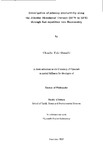Investigation of primary productivity along the Atlantic Meridional Transect (50°N to 33°S) through fast repetition rate fluorometry
| dc.contributor.author | Omachi, Claudia Yuki | |
| dc.contributor.other | Faculty of Science and Engineering | en_US |
| dc.date.accessioned | 2013-10-09T09:30:17Z | |
| dc.date.available | 2013-10-09T09:30:17Z | |
| dc.date.issued | 2003 | |
| dc.identifier | NOT AVAILABLE | en_US |
| dc.identifier.uri | http://hdl.handle.net/10026.1/2100 | |
| dc.description.abstract |
Phytoplankton physiology and primary productivity at basin scales were determined using in situ data from fast repetition rate (FRR) fluorometry. Samples were collected along the Atlantic Meridional Transect cruise 11 (AMTll, September-October 2000), between 50°N and 33°S in the Atlantic Ocean. Because of the large-scale nature of the study, consistent knowledge about oceanographic conditions and the phytoplankton community structure of each sampling station were required. The province analysis was carried out by detecting the regional variations of water mass characteristics in the upper 200 m layer. Temperature versus salinity diagrams were plotted at each station and further analyses of nitrate and chlorophyll were carried out for confirmation of the provinces. The structure of phytoplankton community and its distribution were assessed by statistical analyses of the phytoplankton pigments detected by high performance liquid chromatography. The phytoplankton physiology was assessed with FRR fluorometry to retrieve the quantum yield of photochemistry (Fv/Fm), the effective absorption cross-section (cpsII) and the turnover time of photosystem II (TQA). Some assumptions and parameterisations allowed the determination of primary productivity fractionated for prochlorophytes and eukaryotes from Fv/Fm and apsII- The classification of the regional variation of water masses through temperature and salinity relationships turned out to be a quick and simple analysis for the detection of provinces, defining eight provinces along the transect. Phytoplankton were distributed in three communities which were stratified along the transect. The limits between the communities were at variable depths depending on the province. The shape of the vertical profile of Fv/Fm and its pre-dawn to mid-day variation were also dependent on the province. In the Equatorial upwelling region and at the depth of deep chlorophyll maximum in the oligotrophic gyres, e.g. where nitrate was replete, values of Fv/Fm were relatively low at both pre-dawn and mid-day stations. This persistent low value of Fv/Fm at pre-dawn, e.g. after overnight darkness in nitrate replete conditions, leads to the proposition of iron limitation. In the upper layer of the oligotrophic gyres, nocturnal recovery of Fv/Fm was observed, indicating nitrate limitation rather than iron limitation. In the light limited part of the water column (PB) varied proportionally and consistently to the light intensity. Station analysis of PB showed photosaturation at low light levels at which the radiocarbon method was insensitive. The FRRF method was more precise, reflecting better the environmental conditions at the time of sampling than the results of radiocarbon P-E experiments. The upper layer of Atlantic Ocean was photosaturated due to the physiological impairment caused by either nitrate or iron limitation yet the zone of photosaturated photosynthesis contributed more to the primary productivity of the water column than the zone of light limited photosynthesis. The primary production fractionated for prochlorophytes and eukaryotes, indicated that the former contributed to more than half of the total production in the gyres. FRR fluorometry has been demonstrated to be a promising option for primary productivity studies, especially at basin scales, that allows 'continuous' measurement through the water column. Exploiting the capability of this method is valuable for the understanding of photosynthesis in the natural environment and more important than attempting to reconcile it to the traditional method of radiocarbon incorporation. | en_US |
| dc.description.sponsorship | Plymouth Marine Laboratory | en_US |
| dc.language.iso | en | en_US |
| dc.publisher | University of Plymouth | en_US |
| dc.title | Investigation of primary productivity along the Atlantic Meridional Transect (50°N to 33°S) through fast repetition rate fluorometry | en_US |
| dc.type | Thesis | |
| plymouth.version | Full version | en_US |
| dc.identifier.doi | http://dx.doi.org/10.24382/3382 |
Files in this item
This item appears in the following Collection(s)
-
01 Research Theses Main Collection
Research Theses Main


